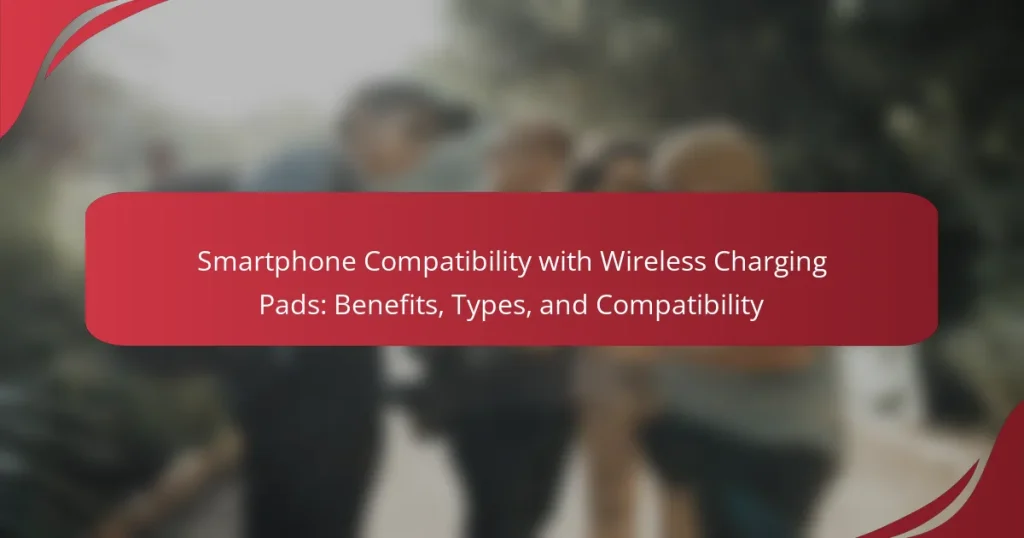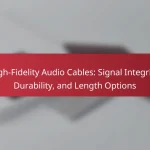Smartphone compatibility with wireless charging pads refers to the ability of smartphones to charge without a physical connection, primarily using the Qi wireless charging standard. Most modern smartphones, including Apple iPhones from the iPhone 8 onwards and various Samsung Galaxy models, support this technology, although compatibility can vary by model and brand. The article outlines the different types of wireless charging pads, such as standard pads, stand-based chargers, and multi-device chargers, all of which utilize Qi technology. It also provides guidance on how users can determine their smartphone’s compatibility with wireless charging pads, including checking device specifications and looking for the Qi logo. Additionally, the article discusses the benefits of wireless charging, such as convenience and reduced wear on charging ports, as well as variations in charging speed among different pads.
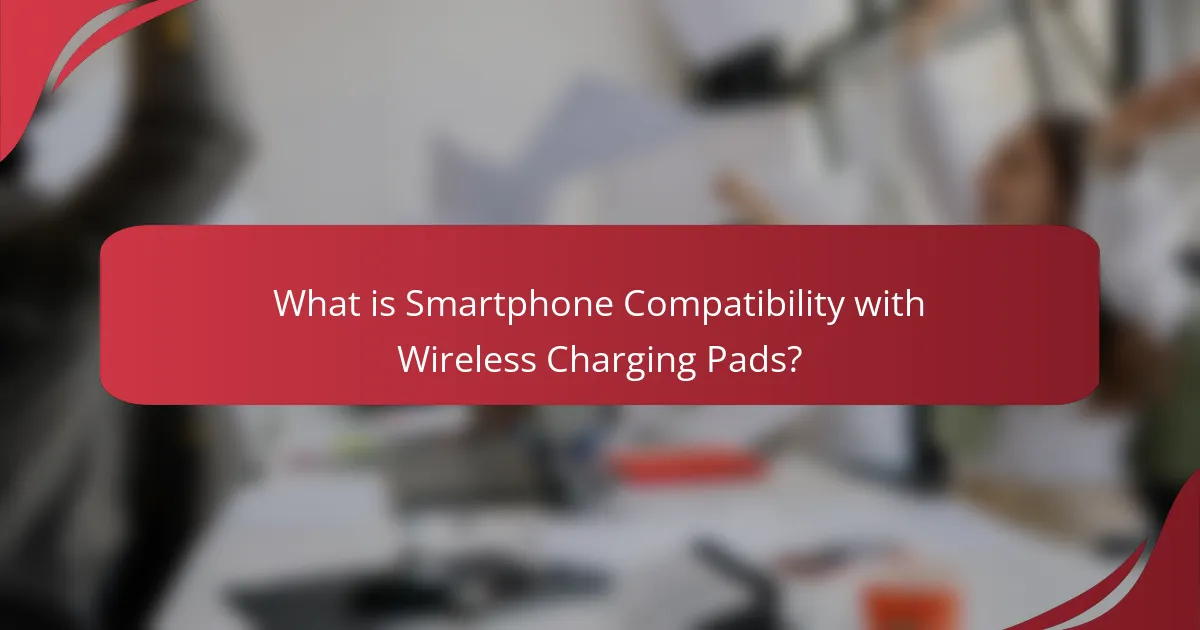
What is Smartphone Compatibility with Wireless Charging Pads?
Smartphone compatibility with wireless charging pads refers to the ability of a smartphone to charge without a physical connection. Most modern smartphones support Qi wireless charging, a standard adopted by many manufacturers. Compatibility varies by model and brand. For instance, Apple iPhones starting from the iPhone 8 are compatible. Samsung Galaxy models also support this technology. Users should check their device specifications for Qi support. Additionally, some smartphones may require specific charging pads for optimal performance. Wireless charging typically provides convenience and reduces wear on charging ports.
How do wireless charging pads work with smartphones?
Wireless charging pads work with smartphones by using electromagnetic induction. The pad generates an electromagnetic field when connected to a power source. This field transfers energy to a coil in the smartphone. The coil converts the electromagnetic energy back into electrical energy. This process allows the smartphone to charge without physical connectors. Most smartphones support the Qi wireless charging standard. This standard enables compatibility across various devices. Wireless charging is generally slower than wired charging. However, it offers convenience and reduces wear on charging ports.
What technology enables wireless charging in smartphones?
The technology that enables wireless charging in smartphones is called inductive charging. Inductive charging uses electromagnetic fields to transfer energy between two coils. One coil is located in the charging pad, while the other is in the smartphone. When the smartphone is placed on the pad, an alternating current generates a magnetic field. This magnetic field induces a voltage in the receiving coil within the smartphone. The induced voltage is then converted into direct current to charge the smartphone’s battery. This method is widely adopted due to its convenience and safety features. Inductive charging complies with the Qi standard, which is recognized by major smartphone manufacturers.
How does the charging process differ from wired charging?
Wireless charging uses electromagnetic fields to transfer energy. This process differs from wired charging, which relies on direct electrical connections. In wireless charging, a charging pad generates an electromagnetic field. The smartphone contains a receiver that captures this energy. The conversion of electromagnetic energy into electrical energy occurs within the device. Wired charging, however, directly channels electrical current through a cable. This results in a faster charging speed compared to wireless methods. According to research, wired charging can deliver up to 100 watts, while wireless typically caps at around 15 watts. Therefore, the efficiency and speed of charging processes vary significantly between the two methods.
What are the benefits of using wireless charging pads for smartphones?
Wireless charging pads for smartphones offer several benefits. They provide convenience by eliminating the need for cables. Users can simply place their smartphone on the pad to charge. This reduces wear and tear on charging ports. Wireless charging pads also promote a clutter-free environment. They often support fast charging, enhancing charging efficiency. Many models are compatible with multiple devices. This versatility allows charging of various smartphones and accessories. Additionally, wireless charging is generally safer, reducing risks of electric shock. Overall, these pads enhance user experience and device longevity.
How does wireless charging enhance convenience for users?
Wireless charging enhances convenience for users by eliminating the need for cables. Users can simply place their devices on a charging pad. This process is often faster than traditional charging methods. Wireless charging pads are compatible with multiple devices. They support various smartphone brands and models. This versatility reduces clutter from multiple chargers. Additionally, users can charge their devices while using them. This multitasking capability improves efficiency. Wireless charging also minimizes wear and tear on charging ports. Overall, it provides a seamless and user-friendly charging experience.
What impact does wireless charging have on smartphone battery life?
Wireless charging can have a mixed impact on smartphone battery life. It typically generates more heat compared to wired charging. Excessive heat can lead to accelerated battery degradation over time. Studies indicate that prolonged exposure to high temperatures can reduce battery capacity. Additionally, wireless charging may cause the battery to cycle more frequently. Frequent cycling can also contribute to a decrease in overall battery lifespan. However, when used properly, wireless charging does not significantly harm battery life if the device is designed for it. Manufacturers often optimize their devices to handle wireless charging efficiently.
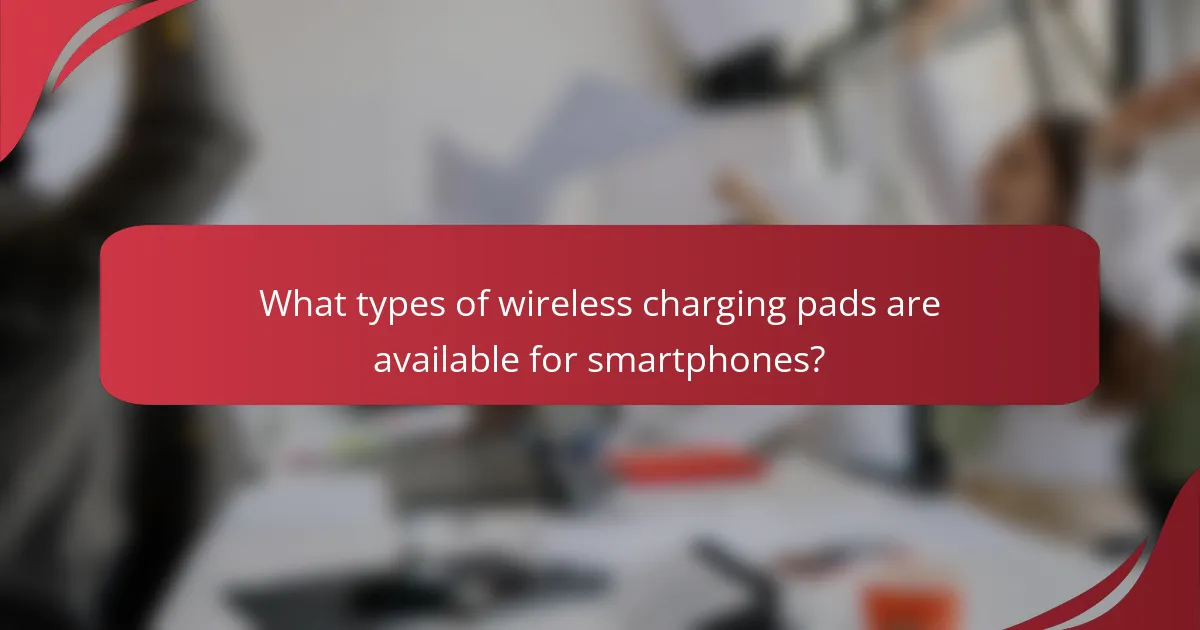
What types of wireless charging pads are available for smartphones?
There are several types of wireless charging pads available for smartphones. The most common types include standard pads, stand-based chargers, and multi-device chargers. Standard pads provide a flat surface for placing the smartphone. Stand-based chargers allow the smartphone to be positioned upright, making it easier to view notifications. Multi-device chargers can charge multiple devices simultaneously, such as smartphones and smartwatches. Each type supports Qi wireless charging technology, which is the industry standard. This ensures compatibility with most modern smartphones. Wireless charging pads vary in charging speed, with some offering fast charging options. Therefore, consumers can choose based on their specific needs and device compatibility.
What are the different designs of wireless charging pads?
Wireless charging pads come in various designs, catering to different user preferences and functionalities. Common designs include flat pads, which provide a simple surface for placing devices. Stand designs elevate the smartphone for easier visibility and access during charging. Multi-device charging pads can simultaneously charge multiple devices, enhancing convenience. Some pads feature built-in cooling systems to prevent overheating. Others offer sleek, minimalist aesthetics, appealing to design-conscious consumers. Additionally, rugged designs are available for outdoor or industrial use, ensuring durability. Each design serves specific user needs while maintaining the core functionality of wireless charging.
How do flat pads compare to stand-style chargers?
Flat pads and stand-style chargers differ primarily in design and usability. Flat pads require the smartphone to lie flat for charging. This can limit visibility and accessibility. Stand-style chargers allow the smartphone to be propped up. This design enables easier interaction while charging.
Charging efficiency is generally similar between the two styles. Both can support fast charging, depending on the specifications. Stand-style chargers may offer better heat dissipation due to their elevation. This can enhance the longevity of the device’s battery.
User preference often dictates the choice between the two. Some users prefer the convenience of a stand for notifications and calls. Others may favor the minimalist design of flat pads. Ultimately, both types serve the same primary function of wireless charging.
What are multi-device charging pads and how do they work?
Multi-device charging pads are platforms designed to wirelessly charge multiple devices simultaneously. They utilize electromagnetic induction to transfer energy from the pad to the devices. Users simply place compatible devices on the pad for charging. The pad typically features multiple charging coils to accommodate different device placements. Most multi-device charging pads support Qi wireless charging standards. This allows for compatibility with various smartphones, smartwatches, and wireless earbuds. The charging process is initiated when a device is detected on the pad. Many models include features like overcharge protection and foreign object detection for safety.
What charging standards do wireless pads use for smartphone compatibility?
Wireless pads primarily use the Qi standard for smartphone compatibility. Qi is the most widely adopted wireless charging standard. It allows for efficient power transfer between the charging pad and compatible devices. Many smartphones from various brands support Qi. This standard enables charging at different power levels, typically ranging from 5W to 15W. Some newer devices can even support higher wattages. The Qi standard is recognized for its safety features and interoperability. This ensures that devices can charge without overheating or damaging the battery.
What is Qi charging and why is it significant?
Qi charging is a wireless charging standard that allows devices to charge without physical connectors. It uses electromagnetic induction to transfer energy between a charging pad and a compatible device. Qi charging is significant because it offers convenience and ease of use. Users can simply place their devices on a charging pad to initiate charging. This eliminates the need for cables, reducing wear and tear on charging ports. Additionally, Qi charging is widely adopted across various brands and devices. As of 2023, over 1,000 devices support Qi charging, enhancing compatibility and user experience.
How do other standards like PMA and A4WP differ from Qi?
PMA and A4WP differ from Qi in their charging methods and efficiency. PMA (Power Matters Alliance) uses magnetic induction for wireless charging. A4WP (Alliance for Wireless Power) employs resonant inductive coupling, allowing for greater distance between the charger and device. Qi, developed by the Wireless Power Consortium, primarily focuses on magnetic induction as well.
PMA and A4WP offer unique features not found in Qi. For instance, A4WP supports multiple device charging simultaneously. PMA has been integrated into some public charging stations, enhancing accessibility. Qi, however, has broader industry adoption and compatibility with many devices.
The differences also extend to charging speeds. A4WP can provide faster charging rates compared to Qi under optimal conditions. PMA’s charging speed is competitive but varies based on device and charger compatibility.
In summary, while all three standards aim to facilitate wireless charging, their methodologies, features, and efficiencies set them apart.
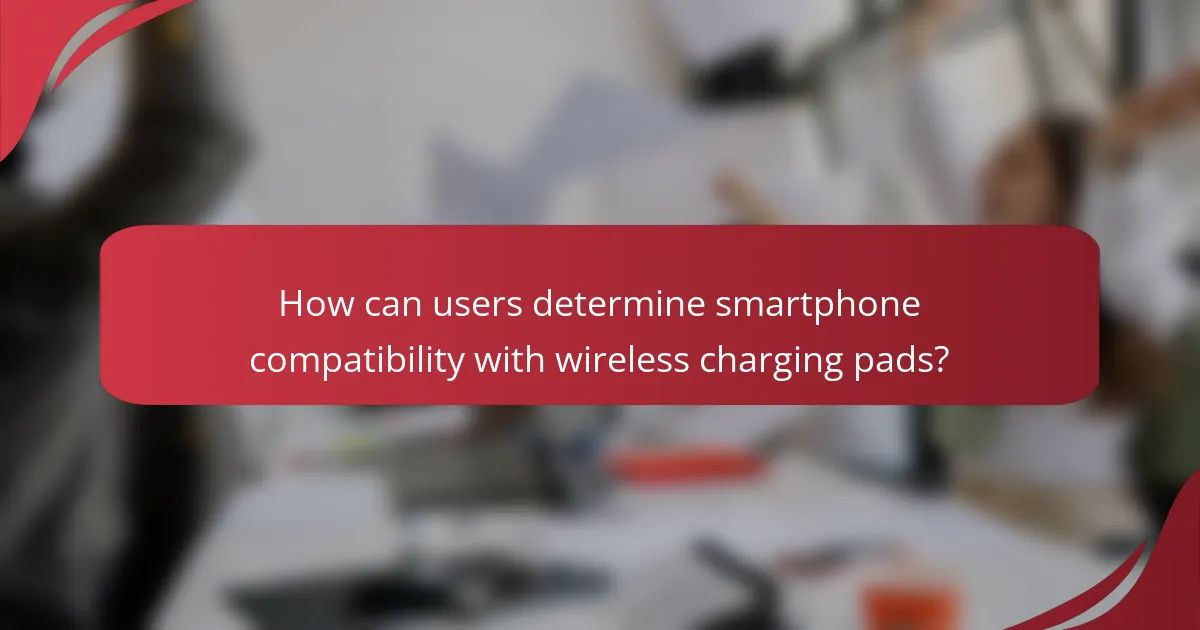
How can users determine smartphone compatibility with wireless charging pads?
Users can determine smartphone compatibility with wireless charging pads by checking if their device supports Qi wireless charging. Most modern smartphones include this feature, but users should verify by consulting the manufacturer’s specifications. Users can also look for the Qi logo on the device or packaging, indicating compatibility. Additionally, smartphone settings may provide information about wireless charging capabilities. Online reviews and forums can offer insights from other users regarding specific models. Lastly, testing the smartphone on a wireless charging pad can confirm compatibility directly.
What features should users look for in their smartphones?
Users should look for battery capacity, processing power, camera quality, and display type in their smartphones. A high battery capacity, such as 4500 mAh, ensures longer usage between charges. Processing power, measured in GHz, affects app performance and multitasking capabilities. Camera quality is important for photography, with features like multiple lenses and high megapixels enhancing image clarity. Display type, such as OLED or AMOLED, improves visual quality and energy efficiency. These features significantly impact user experience and satisfaction.
How can users check if their smartphone supports wireless charging?
Users can check if their smartphone supports wireless charging by reviewing the device specifications. Most manufacturers list wireless charging compatibility in the technical details of the smartphone. Users can also check the official website of the smartphone brand for specific model information. Another method is to look for the Qi logo on the device, indicating wireless charging support. Additionally, users can refer to the user manual that comes with the smartphone. Online forums and tech review sites often provide compatibility information as well. Finally, users can test with a wireless charger to confirm functionality.
What role do smartphone cases play in charging compatibility?
Smartphone cases can significantly affect charging compatibility. They may interfere with wireless charging signals. The material and thickness of the case determine the level of interference. For instance, metal cases can obstruct signals more than plastic or silicone cases. Additionally, cases with built-in features, like cardholders, can also hinder charging. Manufacturers often recommend specific case types for optimal charging performance. Research indicates that cases designed for wireless charging minimize signal disruption. Such cases ensure efficient power transfer between the charger and the device.
What are common issues with smartphone compatibility and wireless charging pads?
Common issues with smartphone compatibility and wireless charging pads include misalignment, case interference, and varying charging standards. Misalignment occurs when the smartphone is not positioned correctly on the pad, leading to inefficient charging. Case interference happens when thick or metallic cases obstruct the charging process. Additionally, different smartphones may support various charging standards, such as Qi or PMA, affecting compatibility. For instance, not all devices are designed to work with every wireless charging pad. These factors can result in slower charging speeds or complete failure to charge.
Why might a smartphone fail to charge on a wireless pad?
A smartphone might fail to charge on a wireless pad due to misalignment between the device and the charging coil. Wireless charging relies on electromagnetic fields. If the smartphone is not positioned correctly, the coils cannot connect. Additionally, the smartphone may not support the charging standard of the pad. For example, some devices require Qi certification for compatibility. Another reason could be a low battery or software issues affecting charging. Furthermore, a dirty or damaged charging pad can obstruct the connection. Lastly, the phone case may interfere with the charging process if it is too thick or made of incompatible materials.
How can users troubleshoot charging problems with wireless pads?
Users can troubleshoot charging problems with wireless pads by following these steps. First, ensure the wireless pad is plugged into a working power outlet. Check if the charging indicator light is on. Next, confirm that the smartphone is compatible with the wireless charging pad. Many smartphones have specific requirements for wireless charging.
Position the smartphone correctly on the pad. Misalignment can prevent charging. Remove any cases or accessories that may interfere with the connection. Some cases can block the charging signal.
Inspect the wireless pad for any physical damage or debris. Clean the surface of the pad and the smartphone’s back. If issues persist, try using a different power adapter or cable. Sometimes, the problem lies with the charging source.
Lastly, restart the smartphone. This can resolve temporary software glitches affecting charging. Following these steps can help identify and fix common charging problems with wireless pads.
What best practices should users follow for optimal wireless charging?
To achieve optimal wireless charging, users should align their smartphones correctly with the charging pad. Proper alignment ensures efficient power transfer. Users should also remove any cases that may interfere with charging. Thick or metallic cases can reduce charging effectiveness. Keeping the charging pad and the smartphone clean is important. Dust and debris can hinder connectivity. Users should avoid placing the phone on the pad when it’s too hot. Excessive heat can damage the battery over time. Finally, using a compatible charger is crucial. Chargers that meet the Qi standard provide the best performance. Following these practices can enhance charging speed and prolong battery life.
How can users maintain their wireless charging pads for longevity?
Users can maintain their wireless charging pads for longevity by keeping them clean and free from debris. Regularly dusting the surface helps prevent overheating. Avoid placing heavy objects on the pad, as this can damage the internal components. Users should also ensure proper alignment of devices to optimize charging efficiency. Using the original power adapter and cable recommended by the manufacturer can enhance performance. Storing the charging pad in a cool, dry place prevents moisture damage. Following these practices can significantly extend the lifespan of the charging pad.
What tips can enhance the charging efficiency of wireless pads?
To enhance the charging efficiency of wireless pads, ensure proper alignment of the device on the pad. Misalignment can lead to reduced power transfer. Use a wireless pad with a higher wattage output for faster charging. Many modern devices support fast wireless charging, benefiting from this feature. Keep the charging pad and the device clean to avoid interference from dust or debris. Regular cleaning can maintain optimal performance. Avoid using cases that contain metal or thick materials, as they can obstruct the charging process. Some cases may cause overheating or slow down charging. Lastly, ensure the wireless pad is placed on a flat, stable surface. This prevents movement that can disrupt the charging connection.
Smartphone compatibility with wireless charging pads refers to the ability of smartphones to charge without physical connectors, primarily through the Qi standard. This article covers the functionality of wireless charging pads, detailing how they work, their benefits, and the various types available, including flat pads, stand chargers, and multi-device options. It also addresses factors affecting compatibility, such as smartphone specifications and case materials, while providing troubleshooting tips and best practices for optimal charging efficiency. Users will gain insights into the technology behind wireless charging, its impact on battery life, and how to ensure their devices are compatible with wireless charging solutions.
